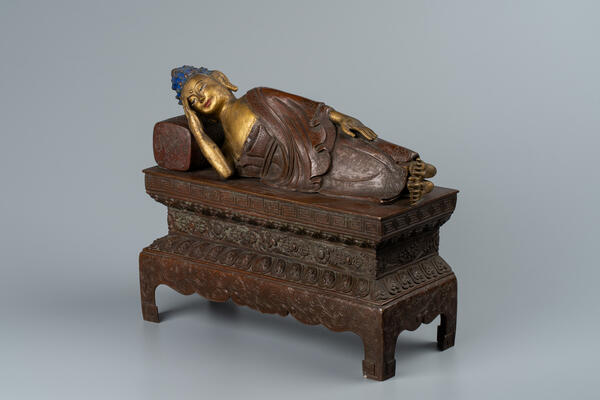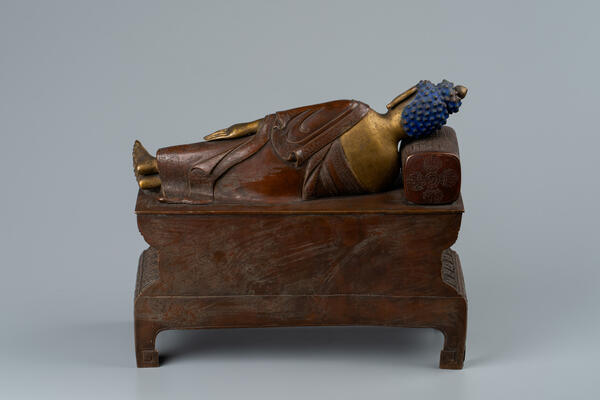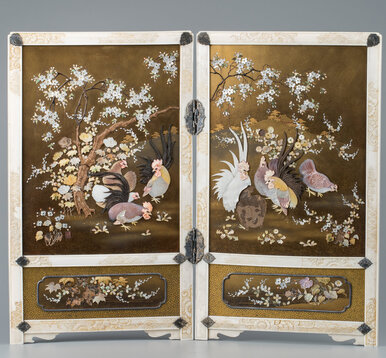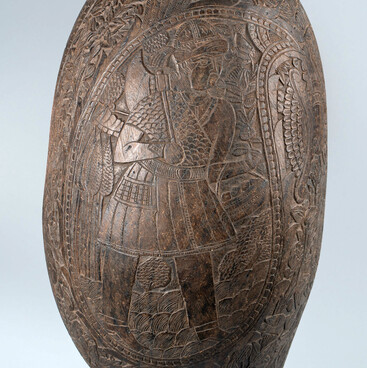The Samara Regional Art Museum presents Buddhist and Lamaist bronze statues which were previously housed in the collection of Aleksei Matveevich Pozdneev (1851 — 1920). He was an outstanding orientalist and Mongolist. He held a doctorate in Mongolian and Kalmyk literature, and was one of the founders and the first director of the Eastern Institute in Vladivostok (presently Far Eastern Federal University). During his research expeditions, he amassed an extensive collection, which is now housed in a number of Russian museums.
One of the sculptures from Aleksei Pozdneev’s collection represents Buddha Shakyamuni who is about to leave this world for nirvana. Buddha is lying on his right side on an exquisitely made Chinese daybed, with his right hand under his head, as if he had just fallen asleep.
“Buddha Shakyamuni” literally translates as “the awakened sage of the Shakya clan”. Siddhartha Gautama was the founder of Buddhism, who preached the dharma (Buddhist doctrine). Buddhism was formed based on his teachings. The dates of birth, religious enlightenment and death of Buddha Shakyamuni are defined differently in different Buddhist traditions: according to the Sinhalese “great” chronicles, Buddha Shakyamuni was born in 624 or 623 BC and reached parinirvana (final nirvana) in 544 or 543 BC (this date is officially recognized by UNESCO).
Shakyamuni was born into a royal family. Until his 29th birthday, he lived in a palace which was specially built for him. Buddha Shakyamuni married Princess Yasodhara, and they had a son, Rahula. According to the traditional biography, once on the streets of Kapilavastu, Buddha Shakyamuni saw four sights, three of which (an old man, a leper and a funeral procession) showed him the instability of samsara (the endless cycle of births and the transition from one existence to another), and the last sight (an ascetic) showed him the path to liberation. After that, Shakyamuni Buddha left the palace and spent six years in the abodes of ascetics. Thus, he began his own quest for liberation. At the age of 35, having defeated the demon Mara who tempted him, he achieved enlightenment (bodhi) and became a Buddha.
Buddha learned that being is suffering, a continuous cycle of rebirths and deaths, and that it is possible to get out of it. He became omniscient and achieved liberation (moksha) from samsara. At the age of 80, Buddha went into parinirvana, which meant his complete disappearance from all planes of existence.
One of the sculptures from Aleksei Pozdneev’s collection represents Buddha Shakyamuni who is about to leave this world for nirvana. Buddha is lying on his right side on an exquisitely made Chinese daybed, with his right hand under his head, as if he had just fallen asleep.
“Buddha Shakyamuni” literally translates as “the awakened sage of the Shakya clan”. Siddhartha Gautama was the founder of Buddhism, who preached the dharma (Buddhist doctrine). Buddhism was formed based on his teachings. The dates of birth, religious enlightenment and death of Buddha Shakyamuni are defined differently in different Buddhist traditions: according to the Sinhalese “great” chronicles, Buddha Shakyamuni was born in 624 or 623 BC and reached parinirvana (final nirvana) in 544 or 543 BC (this date is officially recognized by UNESCO).
Shakyamuni was born into a royal family. Until his 29th birthday, he lived in a palace which was specially built for him. Buddha Shakyamuni married Princess Yasodhara, and they had a son, Rahula. According to the traditional biography, once on the streets of Kapilavastu, Buddha Shakyamuni saw four sights, three of which (an old man, a leper and a funeral procession) showed him the instability of samsara (the endless cycle of births and the transition from one existence to another), and the last sight (an ascetic) showed him the path to liberation. After that, Shakyamuni Buddha left the palace and spent six years in the abodes of ascetics. Thus, he began his own quest for liberation. At the age of 35, having defeated the demon Mara who tempted him, he achieved enlightenment (bodhi) and became a Buddha.
Buddha learned that being is suffering, a continuous cycle of rebirths and deaths, and that it is possible to get out of it. He became omniscient and achieved liberation (moksha) from samsara. At the age of 80, Buddha went into parinirvana, which meant his complete disappearance from all planes of existence.






